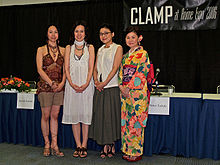There are benefits of creating splintered narratives and transmedia content like CLAMP does. Any additional content to a story gives greater depth and immersion to the audience within the world, or in CLAMP's case, many worlds. One world's point of origin (place where the roots of a story begin), can be another's point of departure (place where the main story begins) and characters from different stories constantly cross paths with each other.
Additional content can include but is not limited to:
- The fictional history of the world
- The background of characters and side characters
- The background of the environment/location
All of these things are present in CLAMP's main productions in its own way and I shall be covering each point individually, illustrating that CLAMP has chosen to focus on 'a particular strand of fandom that combines an attention to continuity detail with a refusal to speculate. (Clarke 2013, 87).
The Fictional History of the World
As mentioned before, CLAMP has many different worlds but claims they all belong to one universe. Some have dubbed this the 'CLAMP' universe as common themes seems to feature in each world and story, such as destined/fated partners and greater forces at work bringing people together. Magic and destiny are big themes in CLAMP works and seen in every one of their stories in some form or another.
In fact, it can be said that the character Yuuko Ichihara, 'the witch of dimensions', who appears in the xxxHolic series and Tsubasa: Reservoir Chronicle series (arguably CLAMP's most popular productions) acts as a conduit for the manga artists to explain how their worlds work. Her most famous quote being 'There is no such thing as a coincidence in this world. There is only the inevitable.'
A good example of this is Watanuki Kimihiro and Yuuko from the xxxHolic series. They occasionally appear in Tsubasa: Reservoir Chronicle but have their own series and backgrounds. This is the same for many characters that are met in Tsubasa in the other worlds the main characters visit.
Granted some are not necessarily the same versions that appear in their individual series, but it is important to note how the same couples/people are always together regardless. This being of course one of CLAMP's tropes.
(Touya and Akito as they appear in Cardcaptor Sakura)
(Touya and Akito as they appear in Tsubasa: Reservoir Chronicle)
As stated before, CLAMP has many worlds/different versions of a world in it's own storyworld universe, and each world is unique and has its own rules. This is most effectively shown in Tsubasa. Harvey (2015) claims that 'fantastic storyworlds afford frameworks which suit transmedial expansion, offering creators and fan-bases coherent ways of suturing together gaps or contradictions in narrative when they occur' (38).
Conclusion
CLAMP has been successful in establishing themselves and building a reputation even though they are a small company. This is due to them being unique in heavily utilising transmedia storytelling and splintered narratives within their manga and anime works. Clarke (2013) says 'we are increasingly caught in a world of media abundance where, texts themselves can no longer be pinned down to single objects, streaming from one to the next' (212). People who read CLAMP's works are fond of seeing familiar characters in another CLAMP series or get curious of a new character and go onto read their story next if the offer is there with the same familiar tropes, worlds and universe. This has been a successful and clever marketing strategy for CLAMP.
References:
Clarke, M.J. (2013) Transmedia Television: new trends in network serial production. United States of America: Bloomsbury Academic
Harvey, C.B. (2015) Fantastic Transmedia: Narrative, Play and Memory Across Science Fiction and Fantasy Storyworlds. United Kingdom, London: Palgrave Macmillan





